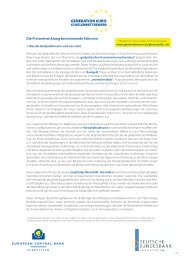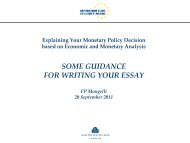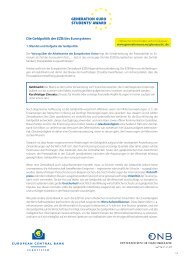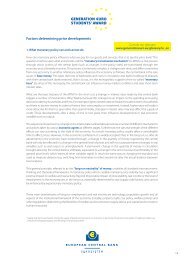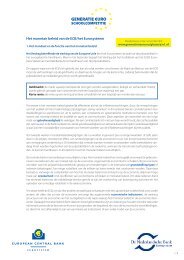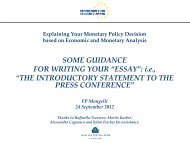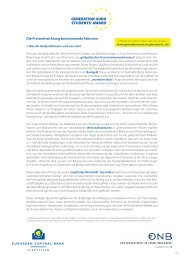Teacher's booklet - the Generation ?uro Students' Award
Teacher's booklet - the Generation ?uro Students' Award
Teacher's booklet - the Generation ?uro Students' Award
You also want an ePaper? Increase the reach of your titles
YUMPU automatically turns print PDFs into web optimized ePapers that Google loves.
Annex<br />
INtroduction to<br />
central banking<br />
and monetary policy<br />
within <strong>the</strong> E<strong>uro</strong> area<br />
This annex 2 provides a brief overview of <strong>the</strong> E<strong>uro</strong>pean<br />
System of Central Banks (ESCB), <strong>the</strong> E<strong>uro</strong>system and an<br />
introduction to <strong>the</strong> monetary policy of <strong>the</strong> ECB. More<br />
detailed information to help you prepare your students for<br />
<strong>the</strong> competition is available in <strong>the</strong> section entitled “About<br />
<strong>the</strong> E<strong>uro</strong>system” on <strong>the</strong> <strong>Generation</strong> €<strong>uro</strong> website.<br />
The E<strong>uro</strong>pean System of Central Banks,<br />
<strong>the</strong> E<strong>uro</strong>system and <strong>the</strong> e<strong>uro</strong> area<br />
Since 1 January 1999 <strong>the</strong> ECB has been responsible for<br />
conducting monetary policy for <strong>the</strong> e<strong>uro</strong> area – <strong>the</strong> world’s<br />
largest economy after <strong>the</strong> United States. The e<strong>uro</strong> area<br />
consists of <strong>the</strong> 17 countries in <strong>the</strong> E<strong>uro</strong>pean Union that use<br />
<strong>the</strong> e<strong>uro</strong>. It came into being when responsibility for<br />
monetary policy was transferred from <strong>the</strong> national central<br />
banks of <strong>the</strong> (<strong>the</strong>n) 11 countries to <strong>the</strong> Governing Council<br />
of <strong>the</strong> E<strong>uro</strong>pean Central Bank (ECB) in January 1999. Greece<br />
joined in 2001, Slovenia in 2007, Cyprus and Malta in 2008,<br />
Slovakia in 2009 and Estonia in 2011. The launch of <strong>the</strong><br />
e<strong>uro</strong> area and <strong>the</strong> creation of <strong>the</strong> ECB were milestones in<br />
<strong>the</strong> ongoing process of E<strong>uro</strong>pean integration. To join <strong>the</strong><br />
e<strong>uro</strong> area, all 17 countries had to fulfil <strong>the</strong> convergence<br />
criteria, as will o<strong>the</strong>r EU Member States prior to adopting<br />
<strong>the</strong> e<strong>uro</strong>. The criteria set out <strong>the</strong> economic and legal<br />
preconditions for countries to participate successfully in<br />
Economic and Monetary Union.<br />
The legal basis for <strong>the</strong> single monetary policy is <strong>the</strong> Treaty<br />
on <strong>the</strong> Functioning of <strong>the</strong> E<strong>uro</strong>pean Union and <strong>the</strong> Statute<br />
of <strong>the</strong> E<strong>uro</strong>pean System of Central Banks (ESCB) and of <strong>the</strong><br />
E<strong>uro</strong>pean Central Bank. The ECB was established as <strong>the</strong><br />
core of <strong>the</strong> E<strong>uro</strong>system and <strong>the</strong> ESCB. The ECB and <strong>the</strong><br />
national central banks (NCBs) toge<strong>the</strong>r perform <strong>the</strong> tasks<br />
that <strong>the</strong>y have been assigned.<br />
The ESCB comprises <strong>the</strong> ECB and <strong>the</strong> NCBs of all EU Member<br />
States, irrespective of whe<strong>the</strong>r <strong>the</strong>y have adopted <strong>the</strong> e<strong>uro</strong><br />
or not. The E<strong>uro</strong>system comprises <strong>the</strong> ECB and <strong>the</strong> NCBs of<br />
those EU Member States whose currency is <strong>the</strong> e<strong>uro</strong>.<br />
The E<strong>uro</strong>system and <strong>the</strong> ESCB will coexist for as long as <strong>the</strong>re<br />
are EU Member States outside <strong>the</strong> e<strong>uro</strong> area.<br />
E<strong>uro</strong>pean Central Bank<br />
The ECB is <strong>the</strong> central bank for E<strong>uro</strong>pe’s single currency,<br />
<strong>the</strong> e<strong>uro</strong>.<br />
Objectives<br />
According to <strong>the</strong> Treaty, <strong>the</strong> main objective of <strong>the</strong> ESCB<br />
is to maintain price stability. Without prejudice to this<br />
objective, <strong>the</strong> ESCB should support <strong>the</strong> general economic<br />
policies in <strong>the</strong> EU, such as full employment and sustainable<br />
development.<br />
The objective of monetary policy<br />
according to <strong>the</strong> Treaty<br />
The Treaty establishes a clear hierarchy of objectives for <strong>the</strong><br />
E<strong>uro</strong>system, assigning overriding importance to price<br />
stability. It also makes clear that ensuring price stability is <strong>the</strong><br />
most important contribution that monetary policy can<br />
make to achieving a favourable economic environment and<br />
full employment.<br />
These Treaty provisions reflect <strong>the</strong> broad consensus that <strong>the</strong><br />
benefits of price stability are substantial. Maintaining stable<br />
prices on a sustained basis is a crucial precondition for<br />
increasing economic welfare and <strong>the</strong> growth potential of an<br />
economy; <strong>the</strong> natural role of monetary policy in an economy<br />
is to maintain price stability. Monetary policy can affect real<br />
economic activity in <strong>the</strong> shorter term, but ultimately can<br />
only influence <strong>the</strong> price level in an economy.<br />
The Treaty provisions also imply that, in <strong>the</strong> actual<br />
implementation of monetary policy decisions aimed at<br />
maintaining price stability, <strong>the</strong> E<strong>uro</strong>system should also take<br />
into account <strong>the</strong> broader economic goals of <strong>the</strong> EU. In<br />
particular, given that monetary policy can affect real activity<br />
in <strong>the</strong> shorter term, <strong>the</strong> ECB typically should avoid generating<br />
excessive fluctuations in output and employment if this is in<br />
line with <strong>the</strong> pursuit of its primary objective.<br />
Basic tasks<br />
According to <strong>the</strong> Treaty <strong>the</strong> basic tasks to be carried out<br />
through <strong>the</strong> ESCB are:<br />
■■<br />
to define and implement <strong>the</strong> monetary policy of <strong>the</strong><br />
Union;<br />
■■<br />
to conduct foreign-exchange operations;<br />
■■<br />
to hold and manage <strong>the</strong> official foreign reserves of <strong>the</strong><br />
e<strong>uro</strong> area countries;<br />
■■<br />
to promote <strong>the</strong> smooth operation of payment systems.<br />
Fur<strong>the</strong>r ESCB tasks<br />
The ESCB is also responsible for a number of additional tasks<br />
in <strong>the</strong> following fields.<br />
■■<br />
Banknotes: <strong>the</strong> ECB and <strong>the</strong> NCBs are responsible for<br />
issuing e<strong>uro</strong> banknotes in <strong>the</strong> E<strong>uro</strong>system.<br />
■■<br />
Statistics: in cooperation with <strong>the</strong> NCBs, <strong>the</strong> ECB collects<br />
<strong>the</strong> statistical information it needs to fulfil its tasks, ei<strong>the</strong>r<br />
from national authorities or directly from economic<br />
agents.<br />
■■<br />
Financial stability and supervision: <strong>the</strong> ESCB contributes<br />
to <strong>the</strong> smooth conduct of policies pursued by <strong>the</strong><br />
relevant authorities in matters relating to <strong>the</strong> prudential<br />
supervision of credit institutions and <strong>the</strong> stability of <strong>the</strong><br />
financial system.<br />
■■<br />
International and E<strong>uro</strong>pean cooperation: <strong>the</strong> ECB<br />
maintains working relations with relevant institutions,<br />
bodies and forums both within <strong>the</strong> EU and<br />
internationally in respect of tasks assigned to <strong>the</strong> ESCB.<br />
The ECB’s Governing Council<br />
The Governing Council is <strong>the</strong> main decision-making body of<br />
<strong>the</strong> ECB. It consists of:<br />
■■<br />
<strong>the</strong> six members of <strong>the</strong> Executive Board;<br />
■■<br />
<strong>the</strong> governors of <strong>the</strong> NCBs of those Member States<br />
whose currency is <strong>the</strong> e<strong>uro</strong>.<br />
Its responsibilities include:<br />
■■<br />
adopting <strong>the</strong> regulations and taking <strong>the</strong> decisions<br />
necessary to ensure <strong>the</strong> performance of <strong>the</strong> tasks<br />
assigned to <strong>the</strong> ESCB;<br />
■■<br />
formulating monetary policy for <strong>the</strong> e<strong>uro</strong> area. This<br />
includes taking decisions relating to monetary<br />
objectives, key interest rates and <strong>the</strong> supply of reserves<br />
in <strong>the</strong> E<strong>uro</strong>system, and establishing guidelines for <strong>the</strong><br />
implementation of those decisions.<br />
Meetings and decisions of <strong>the</strong> ECB’s<br />
Governing Council<br />
The Governing Council usually meets twice a month at <strong>the</strong><br />
E<strong>uro</strong>tower in Frankfurt am Main, Germany. At its first meeting<br />
of each month, <strong>the</strong> Governing Council assesses economic<br />
and monetary developments and takes its monthly<br />
monetary policy decision. At its second meeting, it mainly<br />
discusses issues related to <strong>the</strong> o<strong>the</strong>r tasks and responsibilities<br />
of <strong>the</strong> ECB and <strong>the</strong> E<strong>uro</strong>system.<br />
Although <strong>the</strong> minutes of <strong>the</strong> meetings are not published,<br />
<strong>the</strong> monetary policy decision is explained in detail at a press<br />
conference held shortly after <strong>the</strong> first meeting of each<br />
month. The President, assisted by <strong>the</strong> Vice-President, chairs<br />
<strong>the</strong> press conference, which is divided into two parts:<br />
<strong>the</strong> President first reads out <strong>the</strong> Introductory Statement,<br />
which provides <strong>the</strong> rationale for <strong>the</strong> monetary policy<br />
decision taken by <strong>the</strong> Governing Council and <strong>the</strong>n answers<br />
<strong>the</strong> journalists’ questions.<br />
2<br />
This chapter is based on information available on <strong>the</strong> ECB’s website<br />
(www.ecb.e<strong>uro</strong>pa.eu).<br />
8<br />
9




